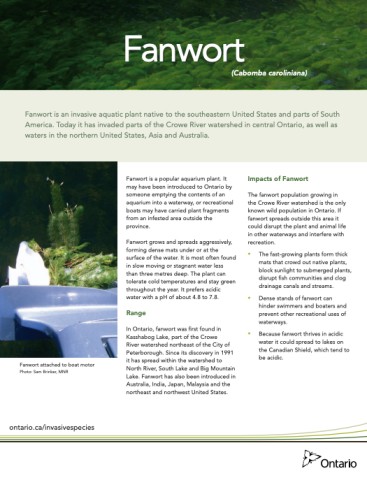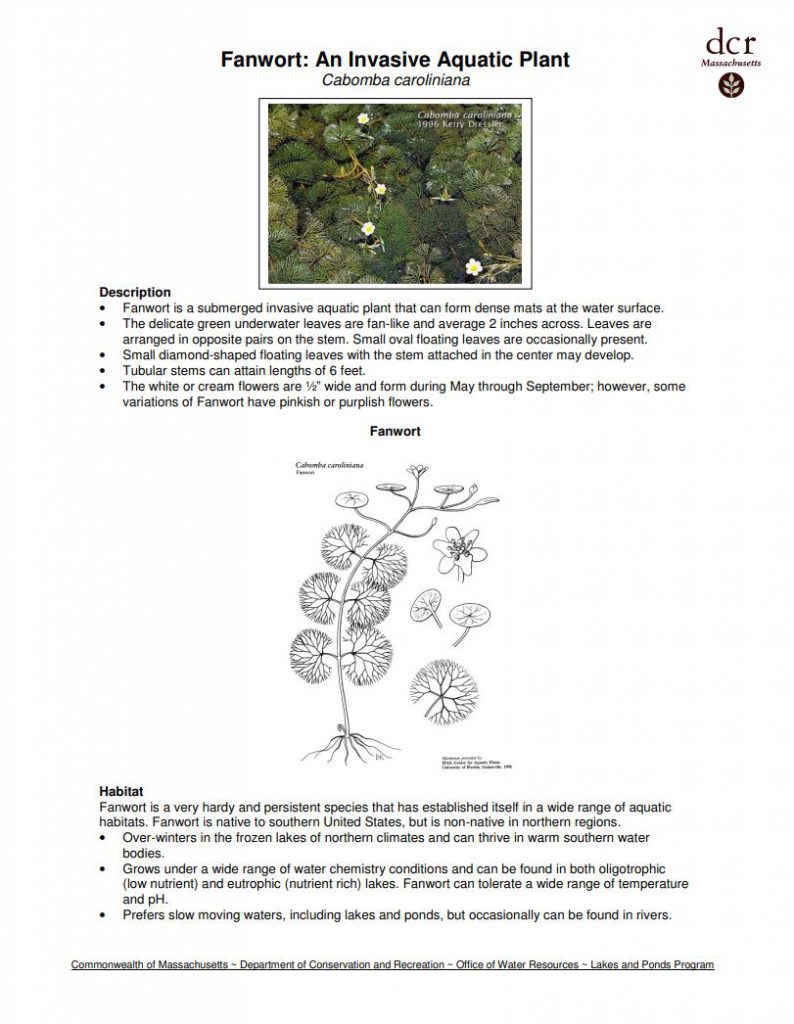Fanwort (Cabomba)
French common name: Cabomba de Caroline
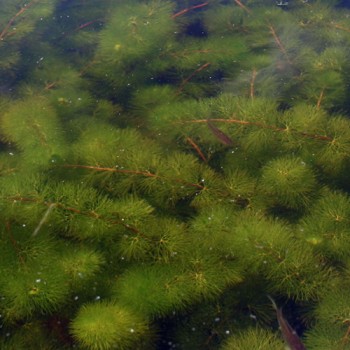
Fanwort is a submerged plant in lakes and rivers that has pairs of finely divided, fan-shaped leaves that grow on opposite sides of the stem, giving the plant a feather-like appearance.
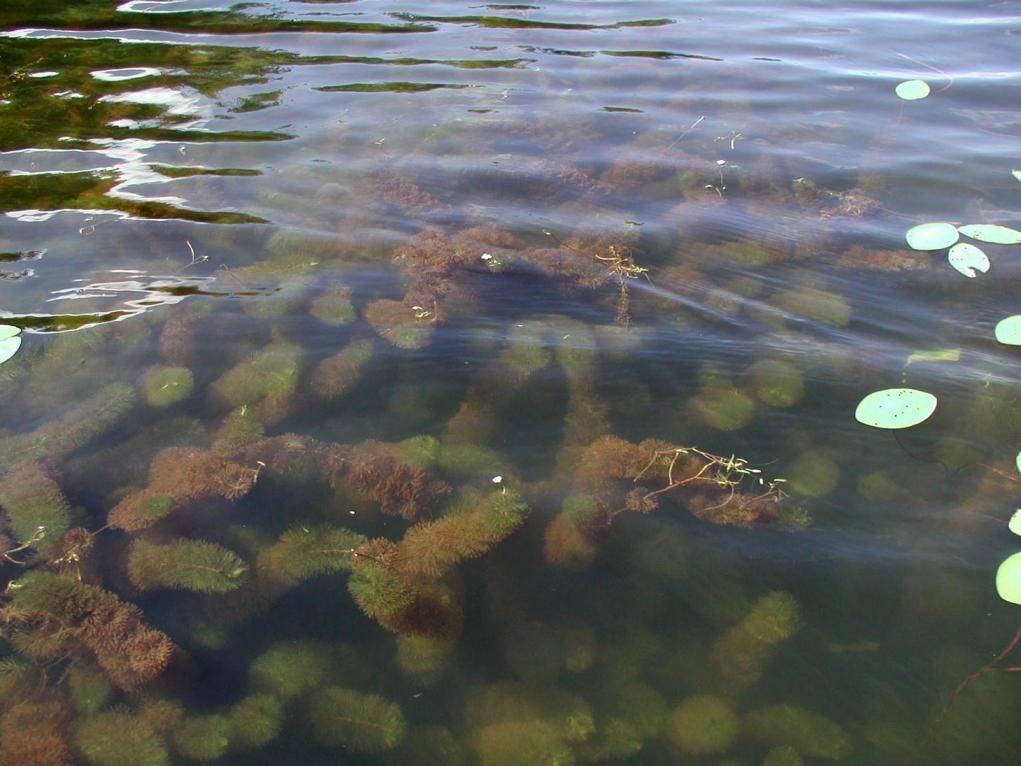
Thick stands can make it impossible to swim, fish, or boat.
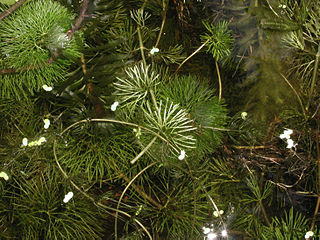
Do not use fanwort in aquariums or water gardens.
Order: Nymphaeales
Family: Cabombaceae
Did you know? Fanwort thrives in acidic waters and poses a great risk to the waters of the Canadian Shield.
Fanwort is a submerged plant in lakes and rivers that has pairs of finely-divided, fan-shaped leaves that grow on opposite sides of the stem, giving the plant a feather-like appearance. It can also have small, oblong leaves that float on the water surface. Fanwort blooms very small (0.6-1.5 cm) flowers in summer and that can be white, yellow, purple, or pink. Fanwort habitat includes silty substrate of stagnant to slow-flowing waters in streams, small rivers, ponds, lakes, and ditches. This aquatic invasive plant occurs in permanent shallow water typically less than 3 m deep. Fanwort grows very fast and can quickly block out native plants, which in turn disrupts the native fish community and can clog drainage systems. It has been reported to grow up to 10 m in length. Thick stands can make it impossible to swim, fish, or boat. Avoid operating recreational vehicles around fanwort patches. Boat propellers can easily break the plants which can lead to new populations establishing.
Fanwort is an herbaceous, submersed, rooted aquatic species (ISSG, 2008) that often grows in water from 0.4-1.2 m and up to 6 m deep (Yu et al., 2004; Schooler et al., 2006).
Fanwort has both submersed and floating leaves. Submersed leaves are oppositely arranged on petioles up to 4 cm long and finely dissected. Flowers are from 6-15 mm in diameter and white/purplish or yellow. The plant is fully submerged and occasionally produces floating leaves and flowers. The plant is rooted, but can survive in a free-floating state for six to eight weeks (ISSG, 2008).
Fanwort grows and spreads aggressively, forming dense mats under or at the surface of the water. It is most often found in slow-moving or stagnant water less than 3 m deep. The plant can tolerate cold temperatures and stay green throughout the year. It prefers acidic water with a pH of about 4.8 to 7.8 (Ontario, 2018). Due to this preference for acidic waters, there is a high risk of establishment in the waters of the Canadian Shield.
How to identify fanwort (Ontario, 2018):
- Fanwort is a submerged plant that roots on the bottom of lakes and rivers.
- Under the water, pairs of finely divided fan-shaped leaves grow on opposite sides of the main stem, creating a feathery effect.
- The plants also have small, floating oblong leaves up to 3 cm long.
- Fanwort flowers from late spring to early fall. The flowers usually rise above the surface of the water. They are 0.6 to 1.5 cm wide and white to pale yellow, sometimes with a purple or pink tinge.
- Fanwort closely resembles other forms of aquatic vegetation, including bladderwort, northern watermilfoil and coontail. The key identification feature of fanwort is the opposite, finely divided leaves on a distinct stem.
Fanwort is an invasive aquatic plant native to the southeastern United States and parts of South America. Today, it has invaded parts of the Crowe River watershed in central Ontario, as well as waters in the northern United States, Asia, and Australia (Ontario, 2018).
In Ontario, fanwort was first found in Kasshabog Lake, part of the Crowe River watershed northeast of the City of Peterborough. Since its discovery in 1991, it has spread within the watershed to the North River, South Lake, and Big Mountain Lake (Ontario, 2018).
The fanwort population growing in the Crowe River watershed is the only known wild population in Ontario. If fanwort spreads outside this area it could disrupt the plant and animal life in other waterways and interfere with recreation (Ontario, 2018).
- The fast-growing plants form thick mats that crowd out native plants, block sunlight to submerged plants, disrupt fish communities, and clog drainage canals and streams.
- Dense stands of fanwort can hinder swimmers and boaters and prevent other recreational uses of waterways.
- Because fanwort thrives in acidic water, it could spread to lakes on the Canadian Shield, which tend to be acidic.
Learn how to identify fanwort and avoid accidentally spreading this plant with your watercraft. This is especially important in Kasshabog Lake, Crowe River, and connecting waterways.
- Avoid infested areas or reduce your speed when travelling near fanwort infestations. Your propeller can break off fragments and spread the pieces to new areas.
- Inspect your boat, trailer, and equipment after each use. Remove all plants, animals, and mud before moving to a new waterbody.
- Avoid planting fanwort in your aquarium or water garden. Aquarium hobbyists and water gardeners should only use native or non-invasive plants, and are encouraged to ask retailers for plants that are not invasive.
- Report sightings to the Invading Species Hotline 1-800-563-7711, or visit Ontario’s Invading Species Awareness Program.
Fact Sheets
Research
[PDF] Fluridone effects on fanwort and water marigold
herbicide fluridone for control of fanwort, and to assess the impact of treatment on the
nontarget plant, water marigold. Treatments included static exposures of 0, 5, 7.5, 10, 15, 20 …
[PDF] Effects of lime addition on the growth of fanwort in softwater systems
dominance by temporarily elevating pH. For submersed aquatic macrophytes restricted to
free CO2 uptake for photosynthesis, the addition of lime may be an effective means of …
The impacts of the non-native macrophyte Cabomba caroliniana on littoral biota of Kasshabog Lake, Ontario
macrophyte, commonly called fanwort, on the Canadian side of the Great Lakes
basin, despite the fact that it was first reported in the 1930s. High …
Further Reading
The Invasive Species Centre aims to connect stakeholders. The following information below link to resources that have been created by external organizations.

